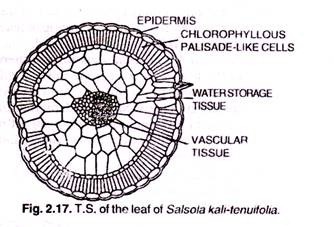ADVERTISEMENTS:
ADVERTISEMENTS:
On the basis of internal structure of thallus, the lichens are divided into two groups, namely, homoiomerous and heteromerous lichens.
1. Structure of Homoiomerous Lichen Thallus:
In the gelatinous lichen thalli such as Collema and Leptogium, the thallus shows a simple structure with little differentiation. It consists of a loosely interwoven mass of fungal hyphae with algal cells equally distributed throughout.
ADVERTISEMENTS:
The algal component in the examples cited above is a blue-green one with the cells arranged in unbranched trichomes. The lichen thallus with the algal component scattered uniformly between the fungal hyphae throughout homoiomerous.
2. Structure of Heteromerous Lichen Thallus:
Most of the lichens belong to this category. They exhibit considerable differentiation and layered structure. The algal component in a heteromerous thallus is restricted to a specific zone or layer.
A vertical section through the foliose thallus such as that of Parmelia or Xanthoria reveals the following four distinct zones:
(a) Upper Cortex:
It forms the upper surface which is generally thick and protective. The fungal hyphae in this region grow more or less vertically and are compactly interwoven to produce a tissue-like layer (Plectenchyma or pseudoparenchyma) called the upper cortex.
The fungal cells in the upper cortex are either closely packed without intercellular spaces between them or with intercellular spaces filled with gelatinous material. Generally the upper cortex has epidermis-like configuration on the surface.
(b) Algal Zone:
ADVERTISEMENTS:
It is the blue-green or the green zone which lies immediately beneath the upper cortex. It consists of a tangled network of loosely interwoven fungal hyphae with the algal cells of a green alga (in Xanthoria) or of a blue-green alga (in Peltigera canina) intermixed with the fungal hyphae.
Common among the unicellular green algae present in this layer are Chlorella, Pleurococcus and Cystococcus. Gloeocapsa is a common example of a unicellular blue-green alga present in this region.
The filamentous blue-green algae found in the algal zone are Nostoc and Rivularia. The algal region is the photosynthetic region of the lichen thallus. Formerly it was called the gonidial layer-a misnomer.
The algal cells multiply by cell division or aplanospore formation. The enveloping fungal hyphae, in some species, send haustoria into the algal cells. The haustoria absorb nutrition for the fungus.
ADVERTISEMENTS:
(c) Medulla:
It forms the central core of the thallus. It is less compact and consists of loosely interwoven hyphae with large spaces between them in certain regions. The fungal hyphae in this region are scattered and usually have thick walls. They run in all directions.
ADVERTISEMENTS:
The central hyphae of the medullary region usually run longitudinally. They become very thick in the region of the vein and thin at the margin. Here and there they give out anastomosing strands.
(d) Lower Cortex:
It forms the lower surface of the thallus and is composed of densely compacted hyphae. They may run perpendicular to the surface of the thallus or parallel to it. Bundles of hyphae (rhizinae) often arise from the surface of the, lower cortex and penetrate the substratum to function as anchoring organs.
In some lichen species the lower cortex is absent. Its place is taken up by a thin sheet of hyphae constituting the hypothallus. It persists chiefly at the margins of the thallus. The rhizines in these species arise directly from the thicker part of the medullary region.
Structures Associated with the Lichen Thallus:
Associated with the lichen thallus are certain other vegetative structures peculiar to lichens only.
The most important or these are:
ADVERTISEMENTS:
1. Breathing Pores:
In certain species of lichens particularly the foliose forms the compact nature of the upper cortex is interrupted at inervals. In these localised areas, which are called the breathing pores, the fungal hyphae are loosely interwoven.
The tissue beneath the breathing pore is more of less medullary in nature. The breathing pores serve for aeration and may be in level with the surface or raised on cone-like elevations on the thallus.
2. Cyphellae (Fig. 20.4):
Aerating organs in the form of organised breaks also occur in the lower cortex of a few foliose forms (Sticta sylvatica). To the naked eye these appear as small cup-like white spots.
Under the microscope each spot is seen as a roundish cavity or a concave circular depression where white medulla is exposed. Here the hyphae grow directly from the medulla and abstrict empty rounded cells in a spore-like manner at their tips.
ADVERTISEMENTS:
Such aerating or breathing pores in the lower cortex may or may not have a definite border formed by the edge of the cortex. In the former case they are called the cyphellae and in the latter pseudocypheliae.
3. Cephalodia (Fig. 20.5 A-B):
These appear as small, hard, dark-coloured, gall-like swellings on the free surface of some lichen thalli such as Peltigera aphthosa. The cephalodium contains the same fungal hyphae as in the thailus but the algal component is always different.
For example, in Peltigera aphthosa the cephalodium contains a blue-green alga but the algal component in the thailus is of a bright, green kind.
4. Isidia (Fig. 20.6):
These are small outgrowths on the upper surface of the lichen thailus each consisting of an outer cortical layer followed by an algal layer of the same kind as in the thailus. The chief function of isidia appears to increase the photosynthetic surface of the lichen thailus.
The isidia vary in form in different lichen species. In Parmelia sexuatilis they are rod- shaped, but coralloid in Umblicaria postulata, cigar-shaped in Usnea comosa, tiny coral-like buds in Peltigora praetexta and scale-shaped in Collema crispum.






